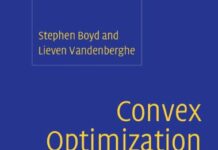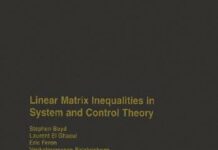
Ebook Info
- Published: 2018
- Number of pages: 457 pages
- Format: PDF
- File Size: 6.54 MB
- Authors: Stephen Boyd
Description
This groundbreaking textbook combines straightforward explanations with a wealth of practical examples to offer an innovative approach to teaching linear algebra. Requiring no prior knowledge of the subject, it covers the aspects of linear algebra – vectors, matrices, and least squares – that are needed for engineering applications, discussing examples across data science, machine learning and artificial intelligence, signal and image processing, tomography, navigation, control, and finance. The numerous practical exercises throughout allow students to test their understanding and translate their knowledge into solving real-world problems, with lecture slides, additional computational exercises in Julia and MATLAB®, and data sets accompanying the book online. Suitable for both one-semester and one-quarter courses, as well as self-study, this self-contained text provides beginning students with the foundation they need to progress to more advanced study.
User’s Reviews
Reviews from Amazon users which were colected at the time this book was published on the website:
⭐The book has a support site with free legal PDF version as well as complementary materials like source codes, links to authors’ courses at Stanford and UCLA which are great. So you can check before you buy.The book is rather unusual. I have never seen an introductory level book with mentioning Toeplitz matrices, Kalman filters, FFT, matrix norms and many others. Authors convey the ideas via real-world examples, which in my view is very good. Supplementary materials with the sources codes help to try things out.As of the cons, I would highlight several things. Almost all material is based on QR factorization and its’ properties, there is no material on eigenvalues and SVD factorization, which are very important and useful topics in many tasks (just check SVD application on any search engine). Authors have provided source codes on Julia language which is not super popular, although it’s not hard, Python would be much more convenient in that sort of problems. Also, I think it’s important to highlight that the book is not rigorous, not even on Strang’s “Linear algebra” level, I would prefer to have a bit more comprehensive mathematics, but I do not think it’s a con, it’s more likely a “feature” of this book.As a conclusion, Strang himself wrote a good review of the book. If you have spare 50 bucks and interesting in linear algebra you should buy it 🙂
⭐This book is very thorough, but after spending ~10 hours trying to learn from it, I have to say it has two critical flaws. First, it presents very simple concepts in very complex ways. From pedantically re-explaining a simple concept from multiple angles, to using awkward, dense language that takes many re-readings to unravel. Like overly clever code. The second critical flaw is, conversely, insufficient information to get from concept A to concept B.For me, these two flaws were insurmountable, even with supplemental support from a friend with a strong mathematics background. Even together we could not figure out some of these lessons. I suspect professor Boyd spends a lot of time with his students explaining book concepts in person, or students have to work extensively with each other, because the book is insufficient alone.For the little I managed to get out of this book, I did find some good things. The practical aspect of it, with 4-6 examples per concept, each tracking a different use case, was great. Some of these examples suffered from the second critical flaw, but those that didn’t helped illuminate why each concept was important.Overall I’m disappointed. I had high hopes, and spent $40 on what will now be donated to a local thrift store. Time to sign up for Kahn Academy or something, which I was trying to avoid.Professor Boyd, if you read this: For the next edition, I’d recommend this be improved with the close assistance of someone actually learning the material from the book. Preferably someone with an affinity for and experience in clearly educating others. Some sections could be reduced by 50% and others slightly augmented, and the book would become far more useful.
⭐This is such a great book on so many level’s… it starts from the basics and uses very precise nomenclature and reasoning through out the book. The book provides numerous examples of how vectors and matrices are used to represent complex real world data and system. Great sections on Least Squares Fitting (i.e. optimization-lite).Check out Dr. Boyd’s site for PDF copy of the book and see for yourself.I bought the hardback copy because I love books and want to support Cambridge Press and the authors fine work… amd I hope you will also. As quality math books go, 50 USD is very fair.Be sure to check the author’s website(s) for: (1) additional resources for this book including a ~200 page guide with Julia code for many of the examples, (2) other free books! (convex optimization is amazing as well).The Julia programming language is a free alternative to MATLAB that is going to be the dominant numerical programming language in the future.
⭐The book is printed in very high quality, in full color.The content is great, I use it for quick lookup of a topics I need.The only downside is – it does not contain exercise solutions, and I did not find any way of obtaining one online (you must be a lecturer in order to be able to get it from Cambridge org website)
⭐This is an excellent book for Linear Algebra and the three things that i really like about the book are:1. The precise use of nomenclature in definitions and explaining concepts2. The books explain concepts with application especially to Machine Learning and Data Science applications3. The free availability of the PDF and slides for the book onlineI would highly recommend this book for anyone looking to pursue graduate level studies in Data Science.
⭐This book is well organized and self contained. Include many interesting exercises and examples from broad spectrum of applied linear algebra including machine learning field: clustering for example.This book can be good companion or the primary book both for linear algebra course or introduction to machine learning
⭐The best book I have ever found for anyone who wants to work on machine learning/deep neural network etc. Lots of practical knowledge points and examples, in the mean time without too much difficult pure math games. Strongly recommend.
⭐This book shows you the practical meaning of linear algebra. Something that most L.A college courses don’t focus on. Highly recommend it!
⭐This book is a treasure of diverse applications ranging from stock market, car control to medical imaging and machine learning. Every piece of theory is justified with clear applications, thus keeping the reader engaged and, at times, absolutely amazed. It is the exact opposite of the usual dry math for math’s sake that people are forced to ingest in school; as such, I would recommend it to anyone who thinks he/she doesn’t like math.Cons: There are standard linear algebra subjects that are not covered in the book. If you buy it in order to cover your linear algebra blind spots, it will not be enough.
⭐Ce livre est un ouvrage idéal pour ceux qui désirent appliquer les outils de l’algèbre linéaires à des applications pratiques dans le domaine de l’Intelligence Artificielle, sciences des données, automatique , traitement du signal, etc… Toutes les applications sont essentiellement traitées sous l’angle de la méthode des moindres carrés avec pour outil de calcul la factorisation QR .Dommage tout de même que l’ouvrage ne traite pas de la décomposition en valeurs singulières qui permet de fournir aussi des solutions aux problèmes des moindres carrés et qui est l’un des outils importants dans le traitement des matrices de données.It seems the book is printed locally. It is not printed on good quality paper. Further the printed fonts are small. Overall not a good buying and reading experience.
⭐Excellent quality in terms of both the content and the printing. Clear explanation of the most important concepts and useful techniques in applied linear algebra with real-world applications. In addition, there are Julia and Python compagnons in the author’s website that implement the algorithms presented in the book.
⭐I’ve tried a few different textbooks for self-study of linear algebra. I found this was quite good in some respects. A key strength is it gives you a lot of examples on how different concepts are actually used – e.g. how audio mixing uses some of the properties of vectors, how you can use these concepts in checking the strength of a bridge in engineering, how concepts are used in finance/business, and so on. That’s a big improvement on most linear algebra books I’ve tried in which you learn concepts but often don’t really have a clue why they matter.Unfortunately it still isn’t great for self-study because it’s written in a typically impenetrable style. Simple concepts that I already knew beforehand seem incredibly complicated here because of the way it’s written. Concepts I had never learned before often went completely over my head.With all that said, I still found this better than other Linear Algebra textbooks I’ve tried. I’m not sure if there really is a better option than this out there and I’ve managed to more or less learn the subject with this and some online courses (the Imperial College London videos on this topic are fantastic). Perhaps one day someone will write a textbook that can actually explain Linear Algebra to beginners but until then I think this is about as good as it gets.
Keywords
Free Download Introduction to Applied Linear Algebra: Vectors, Matrices, and Least Squares 1st Edition in PDF format
Introduction to Applied Linear Algebra: Vectors, Matrices, and Least Squares 1st Edition PDF Free Download
Download Introduction to Applied Linear Algebra: Vectors, Matrices, and Least Squares 1st Edition 2018 PDF Free
Introduction to Applied Linear Algebra: Vectors, Matrices, and Least Squares 1st Edition 2018 PDF Free Download
Download Introduction to Applied Linear Algebra: Vectors, Matrices, and Least Squares 1st Edition PDF
Free Download Ebook Introduction to Applied Linear Algebra: Vectors, Matrices, and Least Squares 1st Edition

